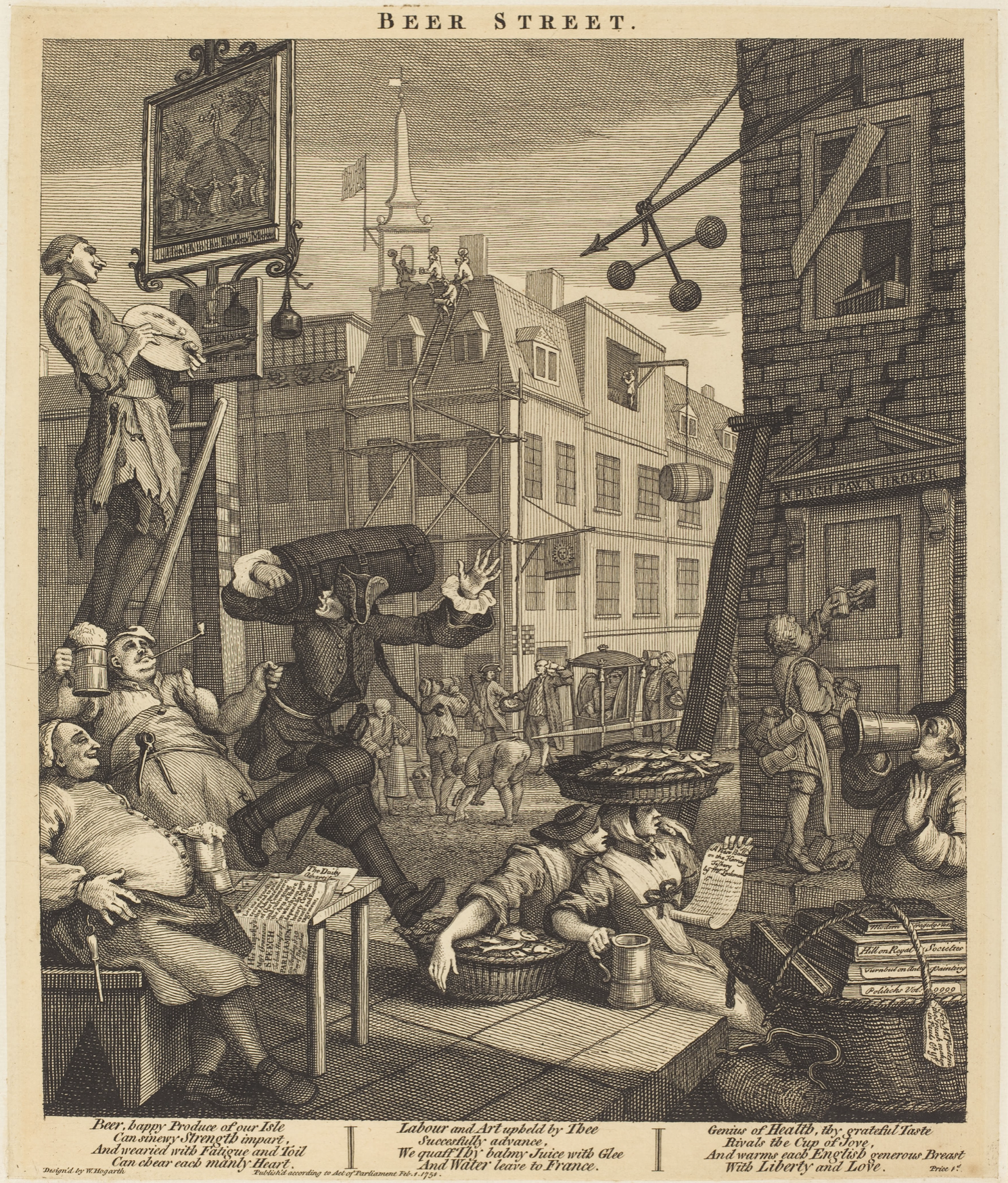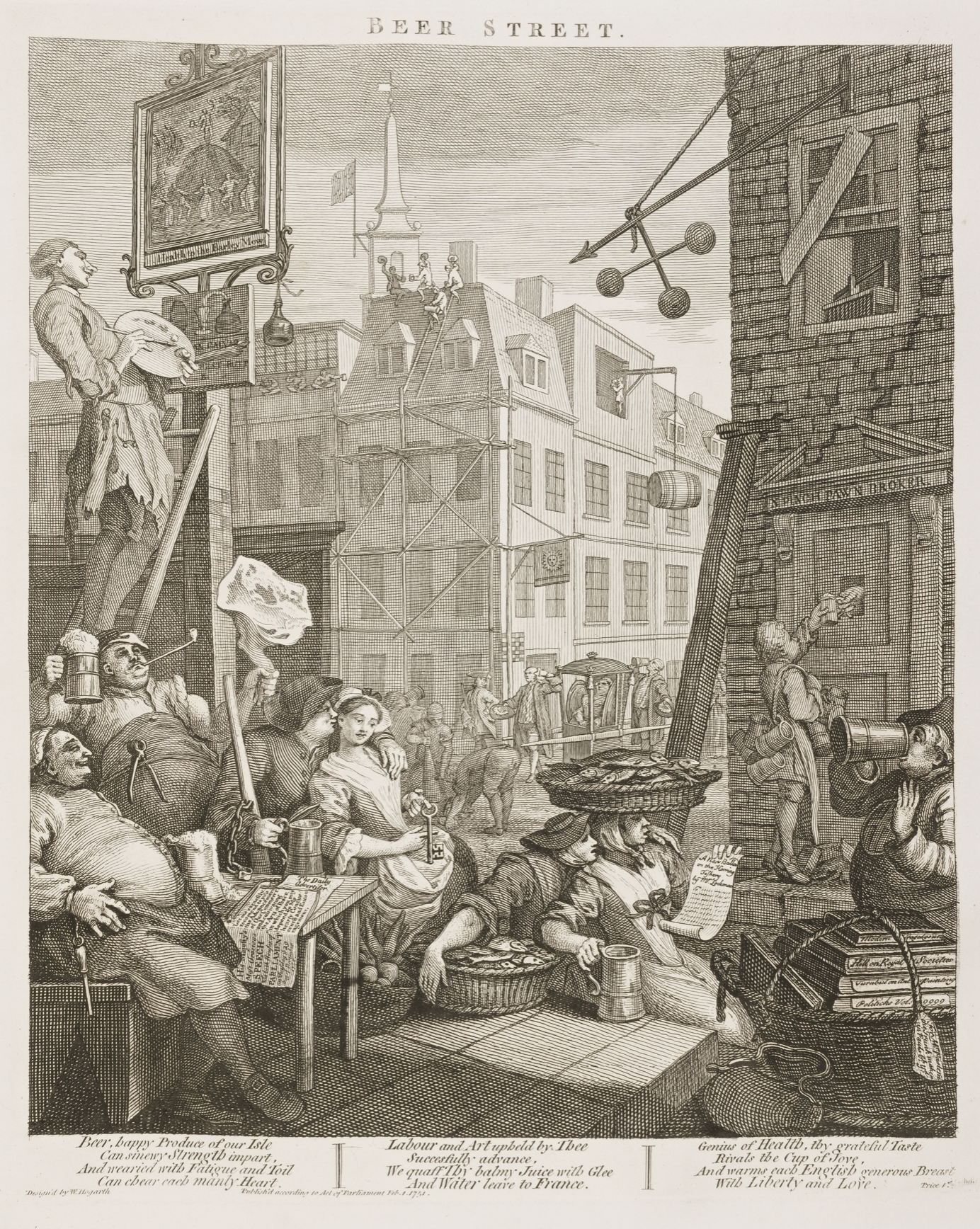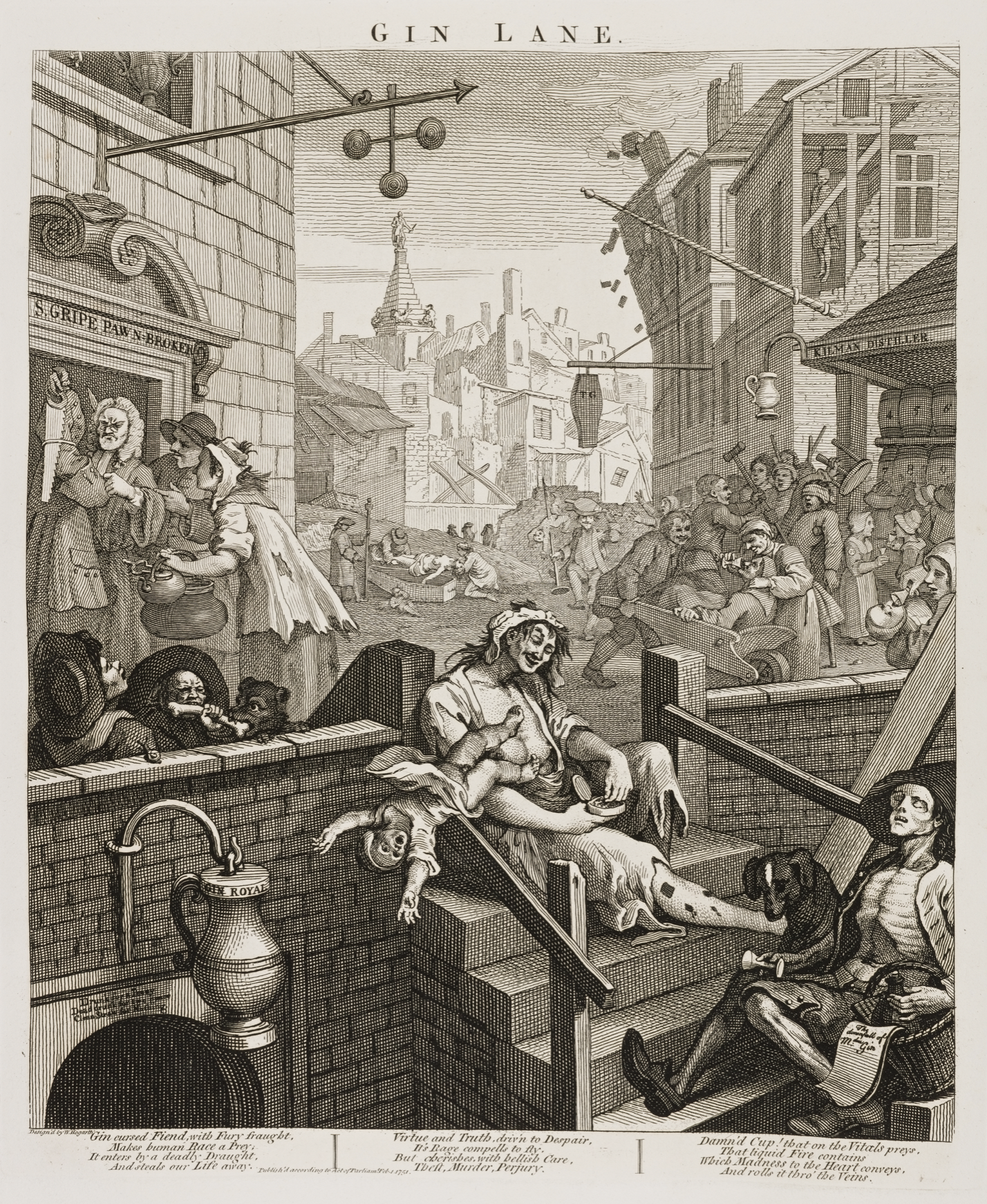Published by British artist William Hogarth in 1751, the popular satirical engravings Beer Street and Gin Lane were part of a campaign to curb gin drinking amongst the poor in London. The prints show the consequences of excessive gin drinking on Gin Lane in comparison with the moderate consumption of ale along Beer Street. The verses at the bottom, written by James Towneley, explain the meaning of the images, but most of the meaning is embedded within the image through the use of symbolism and visual metaphor.
We may recognise parallels with today’s binge drinking but Hogarth was talking to a contemporary audience. Many of his references may seem a bit more obscure now, nevertheless the images still hold a lot of visual language we should recognise.
Compare the two images and identify how Hogarth has used denotation and connotation. What has he shown literally through denotation to support his anti-gin/pro-beer argument and what is implied through connotation? Think about the visual language and symbolic structure he has used to construct meaning – for example, the use of buildings in good repair or disuse, what’s in the foreground and what’s in the distance. What about the pawnbroker’s symbol and the symbolism in the physical language of the human body – the gestures, poses, sizes? There’s even a dead body in there somewhere. How does Hogarth use these to construct meaning?
Document your points of comparison and analysis.
Note: There are two versions of the Beer Street illustration. An earlier version has a French gin seller in the bottom left hand corner being lifted up by his belt by the seated man, holding his beer aloft and a pipe in his mouth. In the later version the Frenchman has been replaced by an animal’s butchered leg. Both versions can be seen below.

Public Domain, via Wikipedia.
(Click on image for larger version, opens in new tab)

Public Domain, via Wikipedia.
(Click on image for larger version, opens in new tab)

Public Domain, via Wikipedia.
(Click on image for larger version, opens in new tab)
Analysing Gin Lane and Beer Street
I carefully studied each of the illustrations and noted down my observations below. I also labelled each point as being either a denotation or a connotation, although in some instances I did find it quite tricky to decide.
Gin Lane
Observations from the foreground of illustration:
- The signpost hanging outside the pawnbroker is in the shape of a cross. This suggests that it has replaced the church as people’s place of worship – CONNOTATION.
- A man and woman are trying to sell their property (their tools, clothes and cooking utensils) to the pawnbroker – DENOTATION. Presumably this in order to fund their gin habit. The pawnbroker is therefore the most powerful (and only sober) individual in the scene – CONNOTATION.
- Apart from the pawnbroker, everyone’s clothes are in tatters, their hair is in disarray and any head covering/hats are askew. This implies the addiction to gin results in an overwhelming lack of pride in one’s appearance – CONNOTATION.
- A man has been reduced to competing with a dog to gnaw on a bone – CONNOTATION.
- Alongside this man, a woman appears to have either passed out or fallen asleep – DENOTATION. A snail is moving towards the woman, which refers to snails being considered a symbol of the ‘sin of sloth’ by Christians – CONNOTATION.
- Situated at the bottom left of the composition, the entrance to the gin den is shown as a dark doorway with the words ‘Drunk for a Penny; Dead drunk for twopence; Clean straw for nothing‘ – DENOTATION. This lays out just how cheaply a person’s life could be destroyed through drinking, but the punter (or victim) is welcome to pass out for free on the straw used for horses – CONNOTATION.
- The positioning of the dark doorway to the drinking den and its implied temptation could be seen as a metaphor of Hell. This possible representation is enhanced by the two characters placed on the staircase leading down to the doorway (discussed next), as it seems that the nearer the entrance to the gin den, the worse the condition of the people becomes – CONNOTATION.
- A man seated on the staircase has the appearance of a corpse, with his skeletal face and uncovered torso – DENOTATION. The only sign of life, for want of a better word, is the fact he is still loosely holding his glass of gin and gripping the bottle. His clothing suggests he is or was a military man – CONNOTATION.
- There is a leaflet in the basket next to the man above, detailing the ‘Downfall of Madame Gin’. A black dog sits beside the man looking at the empty glass – DENOTATION. The inclusion of the mournful black dog suggests depression, sadness and loss – CONNOTATION.
- The most striking character in the composition is a woman seated on the same staircase who is so inebriated that she does not notice (or seem to care) that her child has fallen over the side (down to hell below?). She seems fully preoccupied with checking the snuff pot in her hands. The woman also has sores on her legs, which suggests she has an STD and thus has been prostituting herself to fund her gin habit – CONNOTATION.
Observations from the mid-section of illustration:
- A woman is being placed into a coffin with her crying infant on the ground next to it – DENOTATION. In the context of the illustration, it is implied she has died from drinking gin – CONNOTATION.
- A child has been skewered on a pole, which a man is carrying. This man appears to be dancing and bashing his own head with a pair of bellows – DENOTATION. To the right of this man a woman, mostly likely the infant’s mother, is crying out in grief – CONNOTATION.
- The sign for the undertaker, a coffin, hangs prominently over the scene – DENOTATION.
- A drunk woman is being pushed in a wheelbarrow by two other drunk individuals, one of which is pouring more gin into the woman’s mouth – DENOTATION.
- A brawl is taking place outside the distillery between two disabled men, possibly ex-soldiers, with a baying crowd egging them on – DENOTATION. There is no law and order in this place – CONNOTATION.
- What appears to be two young girls are drinking gin behind a crowd of women outside the distillery – DENOTATION.
- A woman is pouring gin into her baby’s mouth – DENOTATION.
- The distillery is called ‘Kilman Distiller’, which is a none too subtle play on the words ‘kill man’, which is clearly what is happening in the scene as people drink the gin being sold – CONNOTATION.
- In the upstairs of the building between the distillery and the undertaker a man can be seen through the crumbling walls, hanging from a pole – DENOTATION. The position of the man’s body above the ‘Kilman Distillery’ wording must be intentional – CONNOTATION.
Observation from the background of illustration:
- The buildings are either in ruins, collapsing or in complete disrepair – DENOTATION. This implies that any sense of craftsmanship or pride in the area has disappeared. It also could be taken further in suggesting that the the drinking of gin has caused the collapse of society – CONNOTATION.
- The background is mostly empty of any people as everyone is congregating around the source of the gin –DENOTATION.
- There is no order to buildings and so they are positioned higgledy piggledy – DENOTATION.
Beer Street
Observations from the foreground of illustration:
- All of the people in the illustration appear to be in employment, such as the artist painting the sign, the two women with baskets of fresh fish and the two men on the left have tools hanging from their belts – CONNOTATION. This suggests that a life without gin (and drinking beer instead) allows people to prosper – DENOTATION.
- All of the characters are much healthier in appearance than in Gin Lane – DENOTATION. They appear stronger, more industrious and jovial as they go about their business uninhibited by the evils of gin – CONNOTATION.
- There is a copy of a speech by the King present on the table by the two men which states how pleased he is with his subjects and how peaceful, successful a time it is – DENOTATION.
- The artist up the ladder is finishing painting a sign below the main one for the tavern. The latter shows people holding hands in a circle, dancing around around a pile of barley, with a man holding a beer tankard dancing on top of it. The text on the sign states ‘Health to the Barley Mow’ – DENOTATION. This sign reinforces the message that beer is ‘healthy’ and even those who make it are having a jolly good time – CONNOTATION.
- The artist is the only person wearing tattered clothing – DENOTATION. This suggests he may have come from a less prosperous part of London, but is earning a living in Beer Street. On a deeper level the inclusion of the artist could be seen as a warning that the perils of Gin Lane are never too far away – CONNOTATION.
- The two fisherwomen appear to be engaged in conversation with the bookseller regarding the piece of paper in one of the women’s hands – DENOTATION. The large basket of books on subjects including politics and art suggests the characters in this illustration are literate and culturally developed. The bookseller appears to be have been caught mid-gulp by a question from the women – CONNOTATION.
- In strong contrast to his counterpart in Gin Lane, the pawnbroker here, Mr Pinch, is confined to the only dilapidated building in Beer Street. A small pile of packages lies on the step in front of the door and Mr Pinch is receiving his beer through a small hatch in the door. The broken sign of the pawnbroker is prominent in the composition – DENOTATION. All this suggests that through not drinking gin, and choosing beer instead, ‘bad people’ in society get their comeuppance – CONNOTATION.
Observations from the mid-section of illustration:
- Two men are taking a break (and drinking some beer) from carrying a wealthy looking lady who is wedged in a sedan chair – DENOTATION.
- Three men are in the process of repairing the road – DENOTATION. This is in stark contrast to Gin Lane where all the infrastructure had fallen into disrepair. Again this could be inferred as referring to the different state of the society shown in each illustration – CONNOTATION.
Observations from the background of illustration:
- The building in the centre background has scaffolding on one side of it, suggesting maintenance is being carried out. The workers are taking a break on the roof (with beer!) – DENOTATION.
- It is likely the above building is a tavern/brewery and the sign is a sun, which implies goodness, light and happiness. A barrel of beer is hanging by from the top side of the building – which is in strong contrast to the hanging corpse in Gin Lane! – CONNOTATION.
- The clean, modern buildings are arranged very orderly – DENOTATION. This implies that, compared to those in Gin Lane, this place is well-maintained, well-planned and provides safe, clean accommodation for its residents – CONNOTATION.
- The top of St Martin in the Fields can be seen in the distant background with two flags flying from it – DENOTATION.
Further Thoughts
After considering both of the illustrations, I felt that Gin Lane had the stronger underlying message of the two. Hogarth used a greater number of obvious connotations in Gin Lane to infer the pitfalls of a society’s dependency on gin.
The composition of Gin Lane also boosts its message, for example, as previously mentioned, the viewer’s eye is first drawn to the woman in the foreground sitting on the staircase and then to the child falling from her. This leads to the sign of the gin den. The eye travels up to the pawnbroker and then across to the undertaker sign. This trio of signs are very clear and stark in their meaning for the people in the illustration who will most likely follow this path to their doom.
The overriding message of Gin Lane is that it is as a place of despair, misfortune and a downward spiral to doom. Conversely, the message of the Beer Street is that it is a prosperous, peaceful and happy place.
Final Thoughts
I was introduced to William Hogarth during Level 1 and became aware of how he commented on the state of society in his artwork, often in a humorous way (which is not readily apparent in these two examples). I found it very beneficial to spend time analysing how the literal and implied meanings of images can be used to communicate a particular message. The process of working through this Research Point has ensured I will certainly pay more attention to when the use of denotation and connotation has been applied in other examples of illustration, such as adverts.
Bibliography
Royal Academy (n.d.) Beer Street. Available at: https://www.royalacademy.org.uk/art-artists/work-of-art/beer-street-1 (Accessed 10 April 2023)
Royal Academy (n.d.) Gin Lane. Available at: https://www.royalacademy.org.uk/art-artists/work-of-art/gin-lane-1 (Accessed 10 April 2023)
Sooke, A. (2015) Hogarth’s London: Gin Lane and Beer Street – BBC Culture. Available at: https://www.bbc.com/culture/article/20150610-london-city-of-sin (Accessed 11 April 2023)
Wikimedia Commons (n.d.) File:Beer-street-and-Gin-lane.jpg. Available at: https://commons.wikimedia.org/wiki/File:Beer-street-and-Gin-lane.jpg (Accessed 10 April 2023)
Wikipedia (n.d.) Beer Street and Gin Lane. Available at: https://en.wikipedia.org/wiki/Beer_Street_and_Gin_Lane (Accessed 10 April 2023)